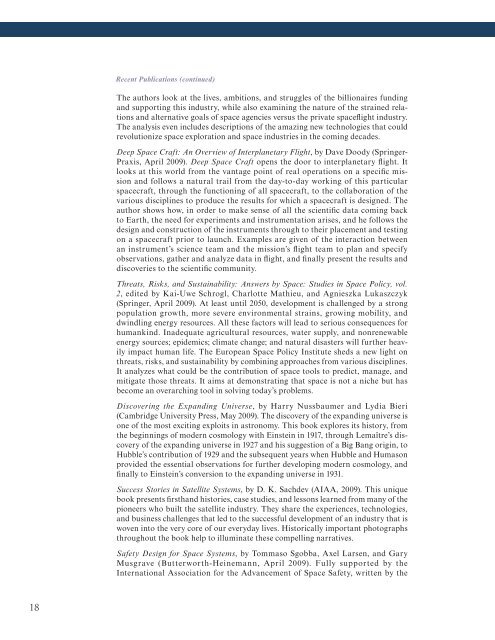FROM THE CHIEF HISTORIAN BORIS CHERTOK'S Rockets and ...
FROM THE CHIEF HISTORIAN BORIS CHERTOK'S Rockets and ...
FROM THE CHIEF HISTORIAN BORIS CHERTOK'S Rockets and ...
Create successful ePaper yourself
Turn your PDF publications into a flip-book with our unique Google optimized e-Paper software.
nasa history division<br />
18<br />
Recent Publications (continued)<br />
The authors look at the lives, ambitions, <strong>and</strong> struggles of the billionaires funding<br />
<strong>and</strong> supporting this industry, while also examining the nature of the strained relations<br />
<strong>and</strong> alternative goals of space agencies versus the private spacefight industry.<br />
The analysis even includes descriptions of the amazing new technologies that could<br />
revolutionize space exploration <strong>and</strong> space industries in the coming decades.<br />
Deep Space Craft: An Overview of Interplanetary Flight, by Dave Doody (Springer-<br />
Praxis, April 2009). Deep Space Craft opens the door to interplanetary fight. It<br />
looks at this world from the vantage point of real operations on a specifc mission<br />
<strong>and</strong> follows a natural trail from the day-to-day working of this particular<br />
spacecraft, through the functioning of all spacecraft, to the collaboration of the<br />
various disciplines to produce the results for which a spacecraft is designed. The<br />
author shows how, in order to make sense of all the scientifc data coming back<br />
to Earth, the need for experiments <strong>and</strong> instrumentation arises, <strong>and</strong> he follows the<br />
design <strong>and</strong> construction of the instruments through to their placement <strong>and</strong> testing<br />
on a spacecraft prior to launch. Examples are given of the interaction between<br />
an instrument’s science team <strong>and</strong> the mission’s fight team to plan <strong>and</strong> specify<br />
observations, gather <strong>and</strong> analyze data in fight, <strong>and</strong> fnally present the results <strong>and</strong><br />
discoveries to the scientifc community.<br />
Threats, Risks, <strong>and</strong> Sustainability: Answers by Space: Studies in Space Policy, vol.<br />
2, edited by Kai-Uwe Schrogl, Charlotte Mathieu, <strong>and</strong> Agnieszka Lukaszczyk<br />
(Springer, April 2009). At least until 2050, development is challenged by a strong<br />
population growth, more severe environmental strains, growing mobility, <strong>and</strong><br />
dwindling energy resources. All these factors will lead to serious consequences for<br />
humankind. Inadequate agricultural resources, water supply, <strong>and</strong> nonrenewable<br />
energy sources; epidemics; climate change; <strong>and</strong> natural disasters will further heavily<br />
impact human life. The European Space Policy Institute sheds a new light on<br />
threats, risks, <strong>and</strong> sustainability by combining approaches from various disciplines.<br />
It analyzes what could be the contribution of space tools to predict, manage, <strong>and</strong><br />
mitigate those threats. It aims at demonstrating that space is not a niche but has<br />
become an overarching tool in solving today’s problems.<br />
Discovering the Exp<strong>and</strong>ing Universe, by Harry Nussbaumer <strong>and</strong> Lydia Bieri<br />
(Cambridge University Press, May 2009). The discovery of the exp<strong>and</strong>ing universe is<br />
one of the most exciting exploits in astronomy. This book explores its history, from<br />
the beginnings of modern cosmology with Einstein in 1917, through Lemaître’s discovery<br />
of the exp<strong>and</strong>ing universe in 1927 <strong>and</strong> his suggestion of a Big Bang origin, to<br />
Hubble’s contribution of 1929 <strong>and</strong> the subsequent years when Hubble <strong>and</strong> Humason<br />
provided the essential observations for further developing modern cosmology, <strong>and</strong><br />
fnally to Einstein’s conversion to the exp<strong>and</strong>ing universe in 1931.<br />
Success Stories in Satellite Systems, by D. K. Sachdev (AIAA, 2009). This unique<br />
book presents frsth<strong>and</strong> histories, case studies, <strong>and</strong> lessons learned from many of the<br />
pioneers who built the satellite industry. They share the experiences, technologies,<br />
<strong>and</strong> business challenges that led to the successful development of an industry that is<br />
woven into the very core of our everyday lives. Historically important photographs<br />
throughout the book help to illuminate these compelling narratives.<br />
Safety Design for Space Systems, by Tommaso Sgobba, Axel Larsen, <strong>and</strong> Gary<br />
Musgrave (Butterworth-Heinemann, April 2009). Fully supported by the<br />
International Association for the Advancement of Space Safety, written by the
















